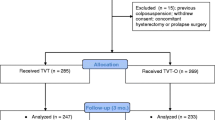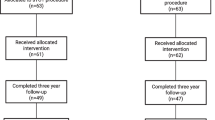Abstract
Introduction and hypothesis
The purpose of this study is to determine if the trans-obturator tape (TOT; Monarc, American Medical Systems (AMS)), which has been claimed to have similar or improved outcomes to retropubic mid-urethral slings, was equivalent (but not inferior) to the trans-vaginal tape (TVT; Gynecare) by using patient-reported outcomes for the treatment of urodynamic stress incontinence.
Methods
The primary outcome was the percentage cured of the symptom of stress urinary incontinence at 12 months on the International Consultation on Incontinence Modular Questionnaire-Female Lower Urinary Tract Symptoms question, ‘does urine leak when you are physically active, exert yourself, cough or sneeze?’. Secondary outcomes included: quality of life, pain scores, global impression of improvement, patient satisfaction and complications. Objective assessments included cough stress test, urinary diary and pad test.
Results
At 12 months, 55 (65.5%) of the TVT group and 59 (63.4%) of the TOT group reported no stress incontinence. TOT was not inferior to TVT. There was less blood loss and pain with TOT than with TVT. There were improvements in quality of life, sexual function and patient satisfaction within groups but not between groups.
Conclusion
Patient-reported outcomes have shown that TOT is not inferior to TVT, but both produce lower success rates than studies using objective measures.


Similar content being viewed by others
References
Hay-Smith J, Mørkved S, Fairbrother KA, Herbison GA (2008) Pelvic floor muscle training for prevention and treatment of urinary and faecal incontinence in antenatal and post-natal women. Cochrane database of systematic reviews, issue 4, art. no. CD007471. doi: 10.1002/14651858.CD007471
Black N, Griffiths J, Pope C, Bowling A, Abel P (1997) Impact of surgery for stress incontinence on morbidity: cohort study. BMJ 315(7121):1493–1498
Ogah J, Cody JD, Rogerson L (2009) Minimally invasive synthetic suburethral sling operations for stress urinary incontinence in women. Cochrane database of systematic reviews, issue 4, art. no. CD006375. doi:10.1002/14651858.CD006375.pub2
Nilsson CG, Palva K, Rezapour M, Falconer C (2008) Eleven years prospective follow-up of the tension-free vaginal tape procedure for treatment of stress urinary incontinence. Int Urogynecol J Pelvic Floor Dysfunct 19(8):1043–1047
Delorme E (2001) La bandelette trans-obturatrice: un procédé mini-invasif pour traiter l’incontinence urinaire d’effort de la femme. Prog Urol 11(6):1306–1313
Rinne K, Laurikainen E, Kivelä A, Aukee P, Takala T, Valpas A, Nilsson CG (2008) A randomized trial comparing TVT with TVT-O: 12-month results. Int Urogynecol J Pelvic Floor Dysfunct 19(8):1049–1054
Ross S, Robert M, Swaby C, Dederer L, Lier D, Tang S et al (2009) Transobturator tape compared with tension-free vaginal tape for stress incontinence: a randomized controlled trial. Obstet Gynecol 114(6):1287–1294
Yalcin I, Bump RC (2003) Validation of two global impression questionnaires for incontinence. Am J Obstet Gynecol 189(1):98–101
Kitchener HC, Dunn G, Lawton V, Reid F, Nelson L, Smith AR (2006) Laparoscopic versus open colposuspension–results of a prospective randomised controlled trial. BJOG 113(9):1007–1013
Barber MD, Kleeman S, Karram MM, Paraiso MF, Walters MD, Vasavada S, Ellerkmann M (2008) Transobturator tape compared with tension-free vaginal tape for the treatment of stress urinary incontinence: a randomized controlled trial. Obstet Gynecol 111(3):611–621
Piaggio G, Elbourne DR, Altman DG, Pocock SJ, Evans SJ (2006) Reporting of noninferiority and equivalence randomized trials: an extension of the CONSORT statement. JAMA 295(10):1152–1160
Haylen BT, de Ridder D, Freeman RM et al (2010) An International Urogynecological Association (IUGA)/International Continence Society (ICS) joint report on the terminology for female pelvic floor dysfunction. Int Urogynecol J Pelvic Floor Dysfunct 21:5–26
Latthe PM, Foon R, Toozs-Hobson P (2007) Transobturator and retropubic tape procedures in stress urinary incontinence: a systematic review and meta-analysis of effectiveness and complications. BJOG 114:522–531
Barry C, Lim YN, Muller R, Hitchins S, Corstiaans A, Foote A, Greenland H, Frazer M, Rane A (2008) A multi-centre, randomised clinical control trial comparing the retropubic (RP) approach versus the transobturator approach (TOT) for tension-free, suburethral sling treatment of urodynamic stress incontinence: the TORP study. Int Urogynecol J Pelvic Floor Dysfunct 19(2):171–178
Novara G, Artibani W, Barber MD, Chapple CR, Costantini E, Ficarra V et al (2010) Updated systematic review and meta-analysis of the comparative data on colposuspensions, pubovaginal slings, and midurethral tapes in the surgical treatment of female stress urinary incontinence. Eur Urol 58(2):218–238
Richter HE, Albo ME, Zyczynski HMD et al (2010) Retropubic versus transobturator midurethral slings for stress incontinence. N Engl J Med 362(22):2066–2076
Araco F, Gravante G, Sorge R, Overton J, De Vita D, Sesti F, Piccione E (2008) TVT-O vs TVT: a randomized trial in patients with different degrees of urinary stress incontinence. Int Urogynecol J Pelvic Floor Dysfunct 19(7):917–926
Hashim H, Abrams P (2006) Is the bladder a reliable witness for predicting detrusor overactivity? J Urol 175(1):191–194, discussion 194–5
Laurikainen E, Valpas A, Kivelä A, Kalliola T, Rinne K, Takala T, Nilsson CG (2007) Retropubic compared with transobturator tape placement in treatment of urinary incontinence: a randomized controlled trial. Obstet Gynecol 109(1):4–11
Porena M, Costantini E, Frea B, Giannantoni A, Ranzoni S, Mearini L, Bini V, Kocjancic E (2007) Tension-free vaginal tape versus transobturator tape as surgery for stress urinary incontinence: results of a multicentre randomised trial. Eur Urol 52(5):1481–1490
Robinson D, Anders K, Cardozo L et al (2003) What do women want? Interpretation of concept of cure. J Pelvic Med Surg 9:273–277
Acknowledgements
We would like to thank Dr Malcolm Waterfield, statistician, Peninsula Medical School.
Conflicts of interest
Professor Robert Freeman: Associate editor for IUJ. Support from Peninsula Collaboration for Leadership in Applied Health Research and Care (Pen CLAHRC). Lecturer at commercially-sponsored meetings for Astellas and Pfizer. Mr David Holmes: No conflict of interest, other than capitation payment from AMS for completed data sets. Significant contribution to data acquisition, analysis and interpretation and drafting, revising and final approval of the article. Mr Timothy Hillard: No conflict of interest. Attended initial study design meeting at Southmead. Mr Mark James: No conflict of interest. Involvement was setting up study design, participated in recruitment and assessment and reviewed paper. Mr Phillip Smith: No conflict of interest. Mr Abdul Sultan: No conflict of interest. Has received speaker honoraria from Astellas.
Mr Roland Morley: No conflict of interest.
Dr Qian Yang: No conflict of interest.
Professor Paul Abrams: Consultant to: Pfizer, Astellas, Novartis, Ono. Study grant from Verathon. Lecturer for: Astellas.
This report/article presents independent research commissioned by the National Institute for Health Research (NIHR). The views expressed in this publication are those of the author(s) and not necessarily those of the NHS, the NIHR or the Department of Health.
Author information
Authors and Affiliations
Corresponding author
Rights and permissions
About this article
Cite this article
Freeman, R., Holmes, D., Hillard, T. et al. What patients think: patient-reported outcomes of retropubic versus trans-obturator mid-urethral slings for urodynamic stress incontinence—a multi-centre randomised controlled trial. Int Urogynecol J 22, 279–286 (2011). https://doi.org/10.1007/s00192-010-1343-6
Received:
Accepted:
Published:
Issue Date:
DOI: https://doi.org/10.1007/s00192-010-1343-6




